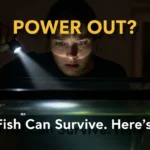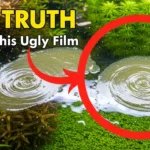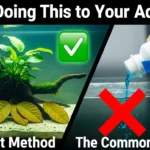You look at your beautiful aquascape, but you can’t see the plants anymore. All you see is that ugly, black, fuzzy stuff clinging to everything. It’s on your driftwood, your filter, and even the edges of your most precious plants. It’s Black Beard Algae, or BBA, and right now, it feels like you’re losing the war.
I know that feeling. That gut-sinking feeling that makes you want to just tear the whole tank down and start over. You feel like you’ve failed, and the thought of restarting from scratch seems easier than fighting this stubborn, hairy monster.
Let me tell you right now: Don’t you dare restart that tank.
My name is Daniel, and my first planted tank was almost completely overrun by BBA. I made every mistake in the book—I scrubbed for hours, I dumped in chemicals, and I almost gave up on the hobby entirely. But through that struggle, I learned a critical lesson: you don’t defeat BBA with brute force. You defeat it by understanding its weakness and bringing your aquarium back into balance.
This isn’t just another guide telling you to buy a bottle of algaecide. This is a rescue mission. This is the 4-step battle plan I used to eradicate BBA from my tank for good, and I’m going to walk you through it, step-by-step.

First, Understand Your Enemy: What is BBA?
Before we fight, we need to know what we’re up against. Black Beard Algae is a tough, wiry type of red algae (even though it looks black or dark purple). It loves to grow in places with high water flow and attaches itself so strongly that algae-eaters often ignore it.
The most important thing to know is that BBA is an opportunist. It thrives when your aquarium is out of balance, specifically when there are fluctuations in your CO2 levels and too much light. Our entire plan is built around fixing that imbalance.
Step 1: The Counter-Attack (Manual Removal & Spot Treatment)
Our first step is to go on the offensive. We need to manually remove as much of the algae as we can to weaken it and give our plants a fighting chance. This gives us a clean slate to begin rebalancing the tank.
How to Do It:
- For Hardscape (Wood & Rocks): Take the affected pieces out of the tank, if possible. Scrub them vigorously with a stiff-bristled toothbrush. You won’t get it all, but that’s okay.
- For Plants: For hardy, slow-growing plants like Anubias or Java Fern, you can do a “spot treatment.” Use a small syringe (the kind for kids’ medicine works great) to apply either liquid carbon (like Seachem Excel) or 3% hydrogen peroxide directly onto the algae. Turn off your filter first so the chemical stays put for about 5-10 minutes before turning it back on. The BBA will turn pink or white and die off within a day or two.
- For Heavily Infected Leaves: Be ruthless. If a leaf is more than 50% covered, just trim it off at the stem. Your plant will thank you by putting its energy into new, healthy growth.

Daniel’s Pro-Tip: Don’t try to do this all in one day. Tackle one section of your tank at a time over a few days. It’s less stressful for you and your fish. The goal is to regain control, not achieve perfection overnight.
Step 2: Cut Off the Supply Line (Fix Your CO2 & Flow)
This is the most important step in the entire plan. Inconsistent CO2 is the number one cause of Black Beard Algae. When your CO2 levels swing up and down during the day, BBA takes advantage of it.
Your goal is a rock-solid, stable level of CO2 from the moment your lights turn on to the moment they turn off.
- For Pressurized CO2 Users:
- Turn your CO2 on at least one hour before your lights come on. This ensures the water is fully saturated with CO2 when the plants need it.
- Aim for a drop checker that is a consistent lime-green color throughout the day. If it’s turning yellow, your CO2 is too high. If it’s blue, it’s too low.
- Check for leaks in your tubing. Even a tiny leak can cause your CO2 levels to drop during the day.
- For Low-Tech / No-CO2 Tanks:
- You can still get BBA. It’s often caused by using too much liquid carbon or having too much light for a non-CO2 setup.
- Ensure you have good water flow. A small powerhead or even just aiming your filter output across the length of the tank can help circulate the natural CO2 produced by your fish.
- Improve Water Flow: BBA loves areas where detritus and organic waste settle. Make sure your filter is clean and the flow is strong. You want a gentle current moving across all the plants in your tank, leaving no “dead spots.”
Key Takeaway: Think of CO2 like your plants’ air supply. If it’s inconsistent, they get weak, and the BBA bully moves in. Stable CO2 is your secret weapon.
Step 3: Control the Energy (Dial In Your Lighting)
Light is the second part of the BBA-causing equation. Too much light intensity, or having the lights on for too long, gives the algae the extra energy it needs to outcompete your plants, especially when CO2 is unstable.
We need to put our plants on a strict, consistent light diet.
- Reduce the Photoperiod: Immediately cut your lighting period down to 6-7 hours per day. This is more than enough for most plants but helps starve the algae. You can slowly increase it back to 8 hours once the BBA is gone.
- Lower the Intensity: If you have a light with adjustable intensity, dim it down by 20-25%. If you don’t have a dimmer, you can raise the light fixture a few inches higher above the tank.
- Use a Timer: Do not turn your lights on and off manually. Use a simple wall outlet timer. Consistency is everything. Your lights should turn on and off at the exact same time every single day.
Daniel’s Pro-Tip: Consider a “siesta” or split photoperiod. Run your lights for 3 hours in the morning, turn them off for 4 hours midday, and then back on for another 3 hours in the evening. Some studies, like this one on algal growth patterns, suggest this break can disrupt algae growth while still benefiting plants.
Step 4: The Long-Term Victory (Clean-Up Crew & Maintenance)
You’ve fought back, cut off the supply lines, and reduced the energy. Now, we need to ensure victory is permanent. This is about long-term balance and having a little help from our friends.
- Introduce a “Clean-Up Crew”: While most fish won’t touch tough, mature BBA, some are great at cleaning up the dying bits and preventing new growth.
- The Best BBA Eater: The Siamese Algae Eater (SAE) is one of the few fish known to actively eat BBA. Make sure you get a true SAE, as they are often confused with other species.
- Other Helpers: Amano shrimp and Florida Flagfish are also known to nibble on BBA, especially when it’s young and soft.
- Consistent Maintenance: A clean tank is a balanced tank.
- Perform a weekly water change of 30-50%.
- Gently vacuum your substrate to remove fish waste and uneaten food.
- Don’t overfeed your fish! Only feed what they can completely consume in about one minute. Excess food breaks down and feeds algae.
- Keep your filter clean, but don’t replace all the media at once, as you’ll lose your beneficial bacteria. For more on this, check out our guide on How to Properly Maintain Your Aquarium Filter.
Key Takeaway: Think of this step as defending your castle. You’ve won the battle, and now you’re posting guards (your clean-up crew) and maintaining the walls (your weekly routine) to make sure the enemy can never get a foothold again.
Your BBA Battle Plan: A Summary
| Step | Action | The Goal |
|---|---|---|
| 1. Counter-Attack | Manually scrub & spot treat BBA. | Weaken the enemy and clear the battlefield. |
| 2. Cut Supply Lines | Ensure stable CO2 & good water flow. | Remove the primary fuel source for BBA growth. |
| 3. Control Energy | Reduce light duration & intensity. | Starve the algae of the energy it needs to grow. |
| 4. Long-Term Victory | Add a clean-up crew & stick to a routine. | Maintain balance and prevent BBA from ever returning. |
You Can Do This
Seeing your tank covered in Black Beard Algae is incredibly discouraging, but it is not a death sentence. It’s a sign that your aquarium’s ecosystem is out of balance, and now you have the exact, actionable plan to fix it.
Follow these four steps patiently and consistently. It won’t disappear overnight, but within a few weeks, you will see the tide turn. The black fuzz will recede, and your healthy, vibrant plants will once again be the star of the show. You didn’t fail—you’re just learning. And this is a battle you can absolutely win.
Now that you’ve mastered how to balance your tank to fight algae, the next step is learning how to supercharge your plant growth. Check out our Beginner’s Guide to Aquarium Fertilizers to learn how to feed your plants what they need to thrive.

Daniel Ravera is the founder of AquaInitium, where he shares insights gained from over a decade of hands-on aquascaping. His expertise lies in the low-tech, ecosystem-first method—a philosophy he adopted after experiencing the common frustrations of algae and instability himself. As an authority in the beginner aquascaping niche, Daniel provides clear, trustworthy advice to help you build a beautiful, stable aquarium and avoid the costly mistakes he learned the hard way.










